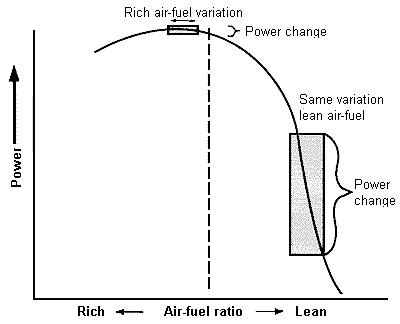I got into a private discussion with a member of the forum about the flow through the venturi. I thought I might take the salient points and put them into this thread for the rest of you guys to peruse. I've also edited the discussion to try and make the points a bit clearer.
-------------------------
XXX, think about an airplane's wing and the shape of the airfoil. The reason the airfoil makes lift is that the air going across the top of the airfoil has to travel a longer distance than the air under the wing. The air has to go faster over the top of the wing, that creates a lower pressure.
The venturi in a carb has the cross-section of an airfoil. The air closest to the surface of the venturi is going faster than the air in the middle of the venturi. Take a look at the flow diagrams of the air flow in a venturi and you will see what I mean.
As the flow through the carb increases, the low pressure area along the surface of the venturi increases and begins to extend further away from the edge of the venturi.
What that means is that if you put the opening of the nozzle on the surface of the venturi it will respond quicker to an increase in flow through the carb. If you put the opening of the nozzle in the middle of the venturi, the low pressure isn't as great and the low pressure on the nozzle tip isn't as great. It takes a while (increasing the revs/flow) before the nozzle detects the same low pressure as the other nozzle on the surface of the venturi.
The nozzle closest to the surface of the venturi will respond sooner and tend to fatten up the mixture at lower revs/flow.
-------------------------
XXX, think about an airplane's wing and the shape of the airfoil. The reason the airfoil makes lift is that the air going across the top of the airfoil has to travel a longer distance than the air under the wing. The air has to go faster over the top of the wing, that creates a lower pressure.
The venturi in a carb has the cross-section of an airfoil. The air closest to the surface of the venturi is going faster than the air in the middle of the venturi. Take a look at the flow diagrams of the air flow in a venturi and you will see what I mean.
As the flow through the carb increases, the low pressure area along the surface of the venturi increases and begins to extend further away from the edge of the venturi.
What that means is that if you put the opening of the nozzle on the surface of the venturi it will respond quicker to an increase in flow through the carb. If you put the opening of the nozzle in the middle of the venturi, the low pressure isn't as great and the low pressure on the nozzle tip isn't as great. It takes a while (increasing the revs/flow) before the nozzle detects the same low pressure as the other nozzle on the surface of the venturi.
The nozzle closest to the surface of the venturi will respond sooner and tend to fatten up the mixture at lower revs/flow.





